Welcome to another Friday roundup! Here are some recent links and stories that caught our eye, perfectly timed for your watercooler discussions and weekend reading. As always feel free to share more in the comments.
Our header image this week is by Patrick Reynolds, and shows Te Komititanga from above.
This Week in Greater Auckland
- On Tuesday, Matt looked at the highlights of Budget 2024 for transport
- Wednesday’s post was the first of two guest posts by Grant A about a better Broadway…
- … and part two ran on Thursday, advancing a possible future for Newmarket
Next week in Greater Welly
If you’re in the capital on Wednesday 12 June, you can catch our very own Patrick Reynolds at the Architectural Centre, 139 Vivian St, at 6pm. Event page here.
(PS There’s also a Welly Urbanerds catch-up the evening before, Tuesday 11 June from 5pm at Waitoa on Victoria St)
And other Welly good news: Councillor Ben McNulty shares a zoning success story. Developers Forma Group are already working on a 12-storey residential building on Vivian St that features 132 quality one- and two-bedroom apartments with “abundant bike parking”, plus a public laneway,…
…but wait, there’s more: Forma will also forge ahead with a “high-end multi-unit residential” project in Mt Victoria – a direct result of the recent rezoning in the District Plan. Boom! Zoning works, fam.
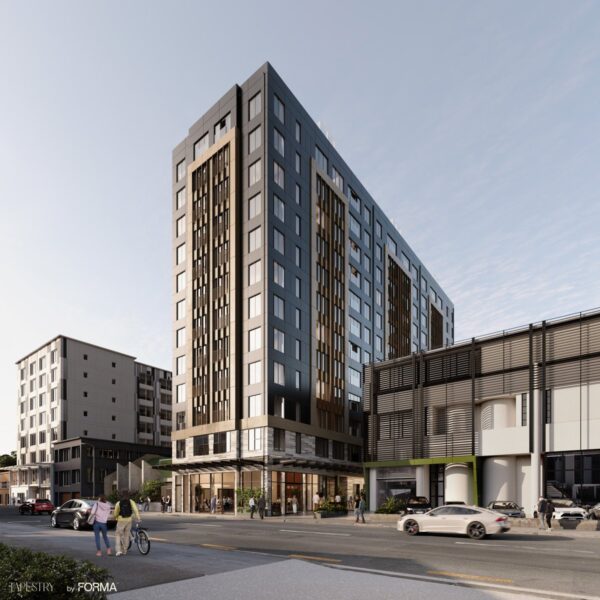

Transit Fanclubs
Public transport fandom thrives on social media, from Talinn Trams to the sassy Tyne and Wear Metro… but did you know there are also dedicated fan accounts for Auckland routes? As reported by 1News, I [Flipping] Love the 70 (classic reel here) leads the pack, and now from the northern express to the southern line, passengers and drivers are sharing the love. Tell us your faves in the comments!
Since late April, more than 30 accounts have sprung up on Instagram, each dedicated to a specific public transport route.
With a combined following nearing the 9000 mark, these pages have changed the routine commute between Point A and Point B into a community-driven affair.
Enthusiasts share updates and sightings of buses and trains on these accounts with the fervour typically reserved for celebrities, and “beef” between routes is not uncommon, as each account engages in good-natured banter and humorous jabs at rival services.
Train Users be Aware
Yesterday AT announced train services will be impacted from tomorrow.
We have been advised by our rail operator, Auckland One Rail (AOR), that train services will be impacted by planned industrial action from Saturday, 8 June.
Off-peak and weekend services will run to their regular frequency. Trains will still be operating for the Blues vs Fijian Drua game on Saturday to Eden Park.
On weekdays, AOR will implement a 20-minute frequency at peak times for train services to cover the resulting shortage of train staff.
There may be some additional cancellations due to resulting staff shortages.
Journey Planner will be updated the evening prior with the latest journey information. Please note there may be some changes each day due to staffing availability.
This week in evidence-led decision-making
- A bouquet to Palmerston North City Council, for voting to proceed with safety, bus, and bike upgrades in Featherston – despite a local petition to scrap the improvements. Onwards!
- Auckland Council reaffirmed support for time-of-use charging, with a solitary vote against from Cr Mike Lee. All eyes are on central government to enact the necessary legislation – perhaps the Minister for Transport and also Auckland and also Local Government and also fast-tracking things could have a word?
- This is in sharp contrast to New York, where as Streetsblog reports, Governor Kathy Hochul (D) announced a last-minute U-turn on congestion charging in NYC, a shocking turn of events. What gives?
Where are our Accessible Streets?
An Onehunga parent has started a Parliamentary petition asking for children to be allowed to cycle slowly on the footpath, regardless of wheel size. Signatures can be added up until 31 July 2024. The petition asks:
That the House of Representatives allow children aged 14 years and under and the adults accompanying them to cycle slowly on footpaths regardless of the wheel size of their bicycles.
I believe: it can be safer for children to cycle on footpaths than on the road; as long as they are cycling slowly children have time to avoid cars coming out of driveways and pedestrians; it is unfair that adults can ride e-scooters on busy footpaths but children are meant to cycle on the road; children already cycle on the footpath and the rules should be changed to reflect this.
It’s been seven years since a previous petition asked Parliament to legalise footpath cycling for children (and drew NZTA support!). Currently, the law bans footpath cycling on wheels larger than 355mm in diameter – which is bigger than most toddler bikes, although weirdly, Brompton-style folding bikes squeak through. The only exception is if you’re delivering mail or pamphlets, in which case you can legally bowl along in a penny-farthing or even one of those NZ Post Paxters.
This is obviously ridiculous, and under the previous government, the Ministry of Transport put forward some well overdue updates. As well as addressing footpath cycling, the “Accessible Streets” package finally acknowledged the existence of scooters, e-bikes, and other 21st C mobility devices, and proposed that drivers give way to buses pulling out from bus stops, and pedestrians crossing side streets.
The proposal was consulted on and publicly debated in 2020…
… and then nothing happened. Absolute crickets, from the government with the largest MMP mandate in history.
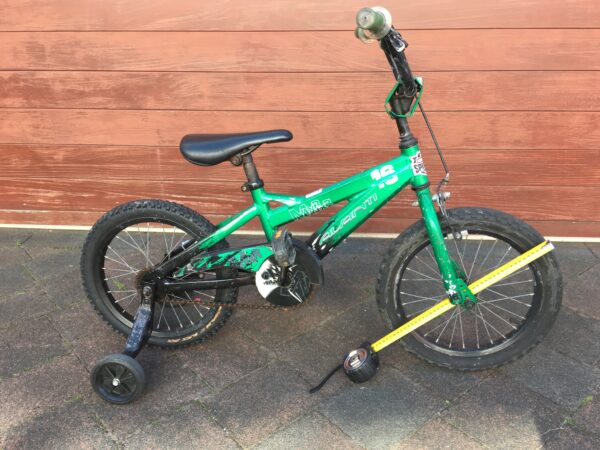
Bikes and Business = Besties?
This Climate Business podcast sits down with Karen Hormann, chair of Bike Auckland, to talk about the synergies between everyday cycling and thriving businesses. Karen also recently spoke with RNZ’s Wallace Chapman on The Panel (at 7m 50s) about the cancellation of Waka Kotahi’s Walk It Wheel It events, and the wider issue of Liberating the Lane.
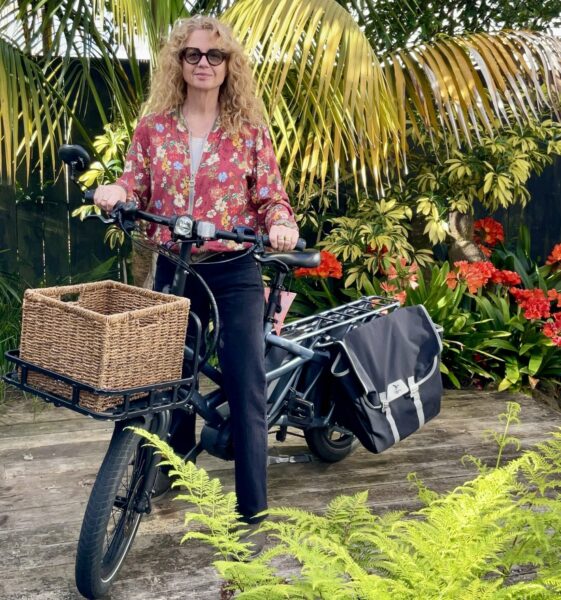
Auckland Ciclovía when?
The Guardian spotlights Bogotá’s Sunday ciclovía, a beloved institution for decades that’s regularly enjoyed by 1.5m people and is a drawcard for tourism. It’s a model so tried and trusted that Auckland is still trying to get its head around it.
Once a week the citizens of Bogotá take back the streets of their city. Every Sunday, between 7am and 2pm, many of the biggest roads are shut to cars and left open to bikes, skates and feet.
“Ciclovía is really cool because there is a lot more space for us,” says seven-year-old Oliver Rojas, who is out cycling with his parents and is baffled to hear that this innovative scheme does not exist in the rest of the world.
…
“It’s a difficult phenomenon to study but I believe that Ciclovía got a whole generation, particularly women, who would not have otherwise used a bike, to get into cycling,” said Olga Lucia Sarmiento, a professor at the School of Medicine at Bogotá’s Andes University.Bogotá’s cycle lane network has expanded in the past decade to around 600km. Gil attributes the rapid growth in part to the popularity of Ciclovía, which puts pressure on politicians to build cycle lanes.
…
The event brings down pollution. On a regular weekday, the level of PM 2.5 particles on the main road through Bogotá feels heavy on the lungs and is dangerously high at 65 µg/m3. During Ciclovía, however, that number falls to 5 µg/m3 on the same stretch of road – 13 times less and in line with the WHO’s recommendations for the tiny, harmful particles. Noise levels are seven times lower.“It’s really important to reduce these harmful chemicals, as when people exercise they pull more air into their lungs. But it’s also a big contribution to climate change, as for 52 days a year, plus public holidays, the air pollution plummets,” Sarmiento says.
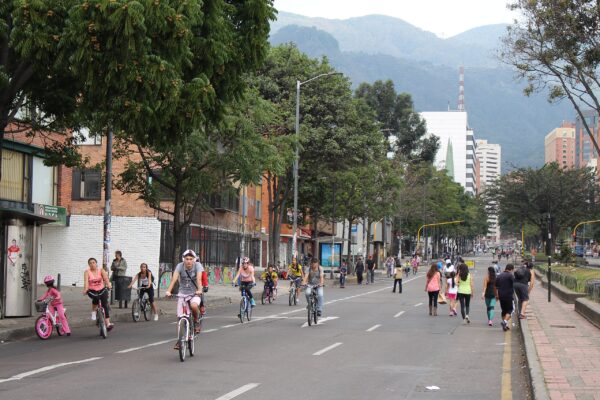
All we need is the air that we breathe…
The cycling revolution in Paris, which almost nobody saw coming, is now contributing to a 40% drop in air pollution.
Meanwhile in Aotearoa: the Ministry for the Environment employs just one full-time-equivalent person to look at air pollution, a striking amount of which comes from vehicle tailpipes, and which contributes to over 3000 preventable early deaths a year. That’s one in every ten deaths, and 10x the deaths from road crashes.
[Minister for the Environment Penny] Simmonds said she was awaiting advice from Ministry for the Environment officials about the “attainability” of the safe limits prescribed by the World Health Organisation.
Meanwhile, the latest global heat index data has the UN Secretary-General urgently calling for “an exit ramp off the highway to climate hell.” And hey, guess what: the more CO2 in the air, the more virulent viruses become Maybe we should do something about this?
For decades, … aerosol scientists and ventilation engineers have mostly thought about CO2 as a sort of indicator for the health of indoor environments. But over the last three years, researchers in the U.K. working with next-generation bioaerosol technologies have discovered that CO2 is more than a useful bystander. In fact, it plays a critical role in determining how long viruses can stay alive in the air: The more CO2 there is, the more virus-friendly the air becomes.
It’s a revelation that is already transforming the way scientists study airborne pathogens. But on a planet where burning fossil fuels and other industrial activities inject 37 billion metric tons of CO2 into the atmosphere each year, it could also have huge implications for human health.
Who’s responsible for dangerous roads?
Here’s a fascinating interview with Wes Marshall, former traffic engineer and author of Killed By A Traffic Engineer: Shattering the Delusion that Science Underlies Our Transportation System. which argues that “[transport] engineering approaches are driven more by ideology and inertia than logic or assessments of what works.”
“Don’t get me wrong – there is a lot of good research out there. But most of it does not end up in those manuals.
I think it’s a combination of inertia and groupthink, because these standards are typically developed by committees. And there’s just the power of these 1,000-page manuals. When I was a young engineer, I assumed that whoever wrote it knew more than I did. I assumed safety is baked into all these decisions. But then when I started to go down these rabbit holes, I was like, wait, what is this based on? Despite the title of the book, I’m not really blaming traffic engineers, because they’re doing what we taught them.”
Beep if you love safe speeds
In California, where 35% of road fatalities involve speed, the legislature is considering European-style speed alerts:
A bill in the California Legislature — which passed its first vote in the state Senate on May 21 — would go further by requiring all new cars sold in the state by 2032 to beep at drivers when they exceed the speed limit by at least 10 mph.
The technology is not new and has been used in Europe for years. Starting later this year, the European Union will require all new cars sold there to have the technology — although drivers would be able to turn it off.
NZ Government drives down EV adoption
The NZ Herald reports on steadily plummeting car sales over the last five months – overall sales are down by a quarter on this time last year, with EV sales hit especially hard by the new government’s policies.
May [2024] new car registrations were brutal reading for the industry. Electric vehicle (EV) sales – stalled by the axing of the Clean Car Discount and the introduction of Road User Charges – remained at a trickle, but the overall market was also laid low by the slow economy and high interest rates.
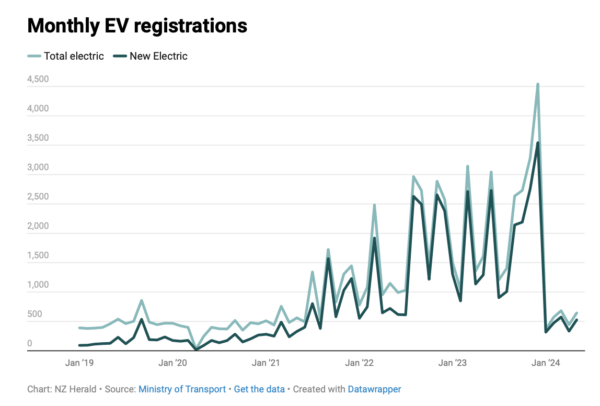
More policy changes look set to double down on this , as covered by Bernard Hickey yesterday, :
Tom Pullar-Strecker reports for The Post [paywalled] that Transport Minister Simeon Brown is pushing ahead with a quiet watering down of emissions standards for car imports without consulting with the public or environmental groups. Brown is trying to push through urgent legislation that would allow him to change the standards without approval from Parliament and he has only consulted car importers.
Electric vehicle advocacy group, Drive Electric, said it wasn’t consulted. It is warning the watering down of the Clean Car Standards on top of the removal of the Clean Car Discount ‘ute tax’ scheme could add 30 million tonnes to Aotearoa NZ’s emissions by 2030, citing a research report published in December last year it commissioned from Concept Consulting. That could cost the Government up to $680 million in emissions credits bought overseas to meet our Paris Agreement commitments.
Breathing space
Here’s a lovely example of a “linear park” in Los Angeles (click through for more pictures). Interestingly, it’s funded by a local clean water initiative.
The park is a simple little thing, with an earthen walk path, a winding concrete two-way bike path, the rain water capture elements, drought resistant native plants, plus a few tables and sanded off tree stumps to sit on, but there’s more to come in the way of immediate connections.
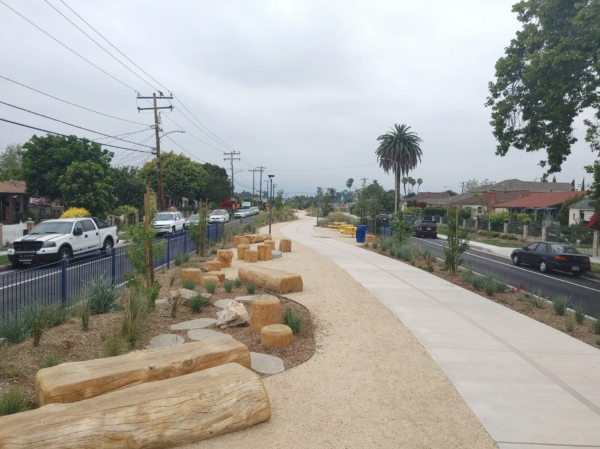
Closer to home, Tree of the Year 2024 is the “Walking Tree”: a northern rātā. Officially outstanding in its field, and strides ahead of the competition, it’s a true pedestrian-rights icon.
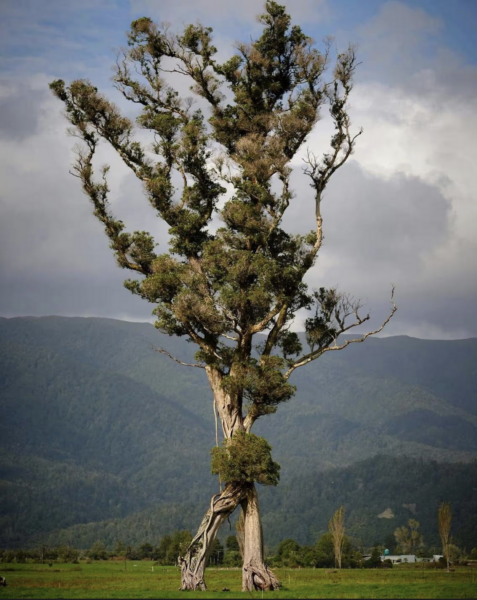
And if you have some room, why not plant an urban microforest? As this local example in Nelson demonstrates, clustering native trees closely together helps them grow faster.
Microforests are also “said to be able to absorb 30 times more carbon from the atmosphere than conventional plantings,” and provide welcome pockets of biodiversity and rainwater absorption in urban areas. They’re also mighty space-efficient – 30m2 is what, two or three car parking spaces?
[Founder of the microforest movement Akira] Miyawaki said a microforest forest as small as 30m² would still thrive, making it ideal for urban planting, [said landowner and microforest advocate Colin Davis].
And here’s a stunning example of breathing new life into old infrastructure: a suspended path for walking and cycling added to a century-old bridge in Luxembourg. Know any local examples we could try this on?
Cartoon of the week
Via Dave Walker: with greater power comes greater responsibility.


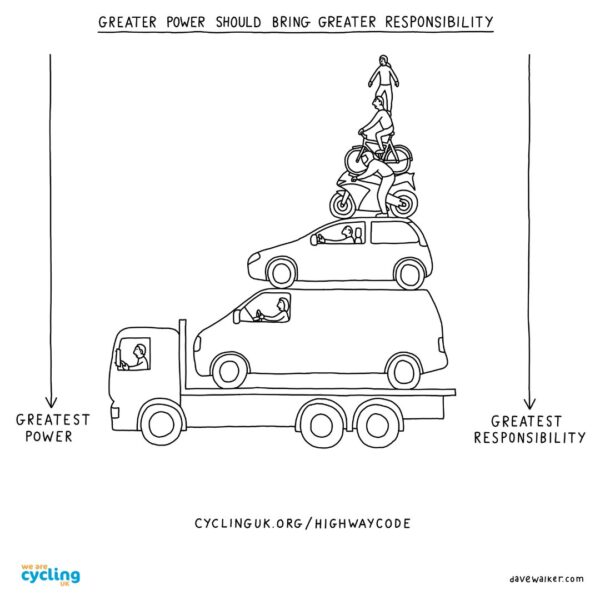

 Processing...
Processing...
It appears that Auckland Transport is so efficient, they decided to make the trains rubbish (even more than usual) one day earlier that planned.
Just getting us ready for the one rail industrial action next week unfortunatly
Fire them all – we don’t need striking workers – technology will do a better job – the sooner, the better for everyone
For all those people talking about how driverless cars are coming “soon”, it is indeed notable that these trains still need a driver.
Why are roads dangerous? Because they are driven upon. Who drives vehicles on roads? Persons.
Just say NO to driving: join us, the carless, the walkers, the bikers, the buses, the ferry catchers, the train enjoyers, the apartment living, coolest people in the world!
Roads are designed for mobility & speed – not safety. Human mistakes on roads are guarantee like weather events. Continuous road safety improvements, improving public transport & more active modes, such as walking, cycling can reduce significantly the danger of using transport travel modes in cities.
That suspended bike bridge is pretty cool addition to an historic structure.
Yes, children should be able to cycle on the path. I think adults too when there is no safe alternative, ie nearly every road in NZ. Doing so may help motivate some cycle infrastructure to be built.
Trump’s destruction of NYC continues – keep repeating that congestion charging will be an economic disaster and you can block without even being in office. Very similar to the side-lining of Accessible Streets for fear of backlash.
Roads are built built on publicly owned corridors.
Corridors primarily to maintain access to and connectivity between publicly and privately held lands and the activities that occur on them.
The 20th C saw grossely undue emphasis placed on just one mode of transport, the private car. Not only for facilitating moving these things, but also for storing them between uses. So other modes, and uses of these corridors was sacrificed for one mode. A spacially inefficient mode but tolerable when traffic volumes were low.
But as car volumes grew above the available space, the adopted solution has been very largely just take more space. Provide another lane, and another carpark, until recently, very likely another publicly owned carpark.
Intensification means that this solution has now run it’s course.
More tar seal means less land for anything else.
And more tar seal and vehicle movements and vehicle storage considerably degrades the enviroment.
This degradation is now very significant in Newmarket considerably reducing both it’s commercial and amenity values.
It’s a shit of a mainstreet for every function it needs to perform.
The answer is not let it rot, and just build another mega mall out in on the fringes.
Newmarket will remain a very strategic mode.
I applaud Grant A in putting forward options in taking Newmarket forward.
I think over emphasis on seeking local business inputs into improvement options to often counterproductive.
A big factor in most business is their rent.
And their rent demanded is a factor of the overall desirability of the area to other operators. So an area going upmarket may well disadvantage existing operators.
Degrading the local environment. This degradation has now become significant in commercial centres such as Newmarket. The answer is not ever more remote malls.
Intensificatio
We must use spacially more efficient means of passing through a location, and more inviting solutions for being in a location.
Apologies for not properly editing before pushing send
It is actually those little things like Simeon brown’s emissions changes that really matter but don’t always get the headlines. At what point do we call these clowns out for being actual criminals?
And those NZ post things go way faster (and quieter) than any kids bike on footpaths..
Barry, you called it, this government are not climate clowns, but climate criminals. Free willy Jones, Minister of One Liners, Killing Dolphins and Widespread Environmental Destruction confirmed it when he overturned the oil and gas exploration ban. Note that this was only two days after Guterres said that the world needs to reduce fossil fuel use by 30% by 2030.
Well for the cycling on the footpath thing, just do it. Those 4 pedestrians and 0.2 cyclists you typically see on a footpath will be able to share that space just fine.
For cyclists, note that this is a very slow option, you’re usually limited to not much above walking speed by sightlines — if a pedestrian steps out of a driveway onto the footpath, you must be able to stop.
But at least it exists. For primary school kids it is pretty much the only option if they want to ride a bicycle.
Or just take some space away from the most inefficient user of it.
Does anyone actually know why the Accessible Streets proposals were not/have not been progressed? It seemed like such a collection of low-hanging fruit for encouraging more non-car based transport. I really thought they would implement it, or at least the non-controversial aspects of it. Such a disappointment.
This week in New RONSLand Simeon brown did more budgetary slight of hand promising up to $3.9B (yes, that a B for Billion) to fix potholes in the roadway pavements;
https://www.rnz.co.nz/news/political/518828/transport-minister-simeon-brown-reveals-1-point-6b-boost-for-pothole-fund
Lets look at the maths of that.
There are ~11,000kms of StateHighways in NZ according to Wikipedia.
$3.9B divided by 11,000 is give or take $350,000 per km. Lets say it’s $10,000 to fix a pothole that suggests 35potholes per road Km of the NZ state highway network. That’s one EVERY 28m (more or less).
I drive the South Island state highway network a lot, probably too much, but I do use an EV and I don’t see a pothole every 28meters. Maybe one ever KM.
So what the F**K is going on here, either wikipedia or my maths are extremely suspect or someone is pulling over Simeon’s eyes or he’s pulling the wool over our eyes.
Can someone with a little more insight to what’s going on here please explain.
The maths is wrong because about 1/2 is for local roads. That article doesn’t make it that clear I think.
Even if half goes local that’s still 14 potholes per state highway KM.
Wikipedia also says there are 83,000 kms of local roads.
Using the same $10k per pothole for half the money that’s two potholes for EVERY local road km in NZ.
Still over the top.
Maybe the NLTP will make this clearer.
It is a lot, I agree too much spending on roads, but I do believe there is a lot out or pot holes out there. They recently did our road with big sections of fix-ups rather than a tiny patches or doing the whole road again. I guess the cost is preventing/re-surfacing roads not literally just plugging a pot hole with a cheap temporary patch.
Auckland Council being taken to high court over downtown carpark sale https://www.rnz.co.nz/news/national/518944/auckland-council-taken-to-court-over-decision-to-sell-downtown-car-park-building
Of course, the irony is that if car parks are such a great investment then the private sector would be popping them up everywhere. I don’t travel into the city so much these days, but I am appalled at the seemingly low use of the AT parks. Knock them all down, sell the land, and put the money into the Auckland fund.
Krukziener, it’s not 1967 anymore.
Maybe he just wants a deal on the Victoria St carpark to build Metropolis 2?
Thats what doesn’t come out in the article but presumably will in the court hearing; how underutilised the carpark currently is.
I also note he and his “Save Queen St” group (of one?) also fought recent lower Queen St pedestrianisation and PT-enhancing improvements.